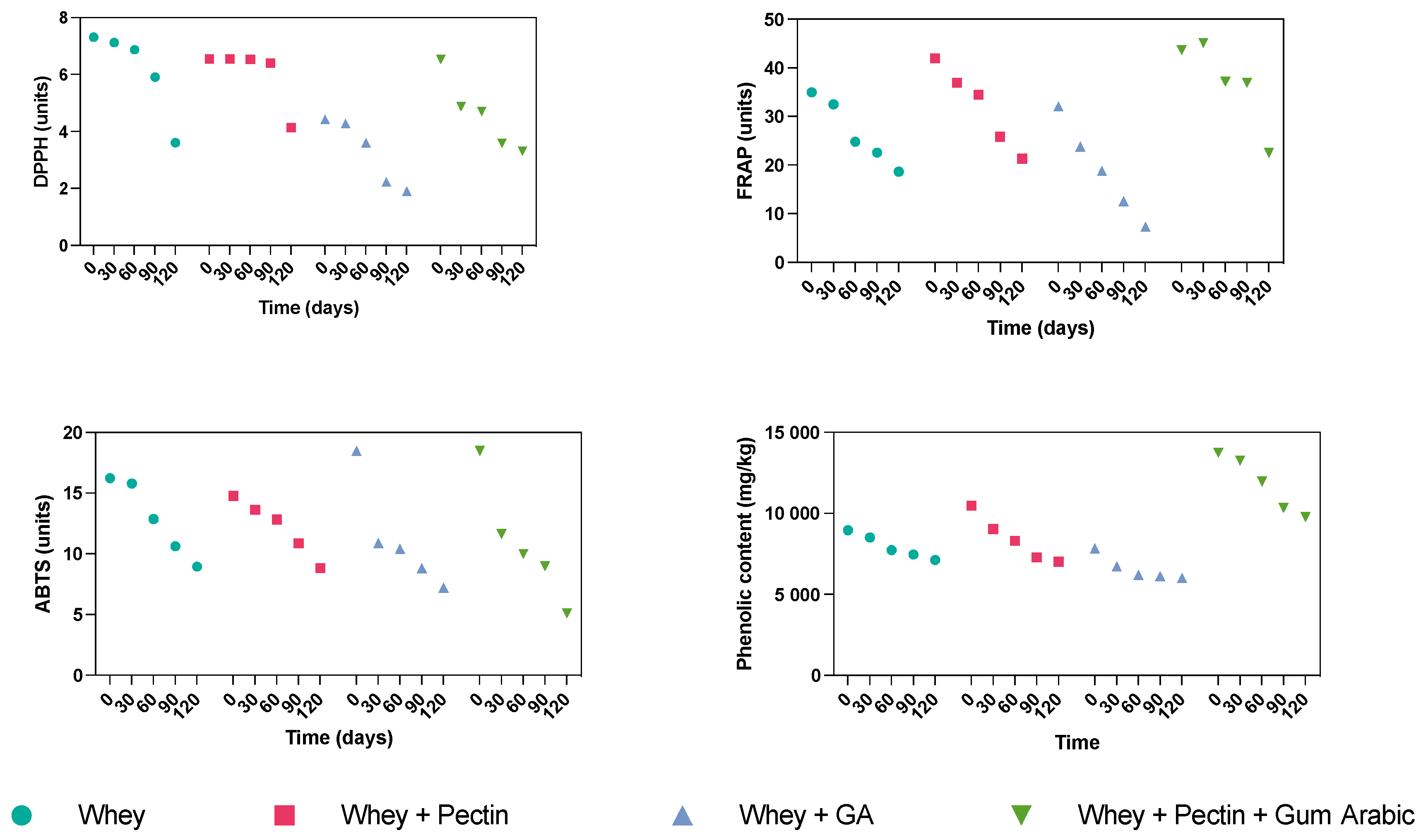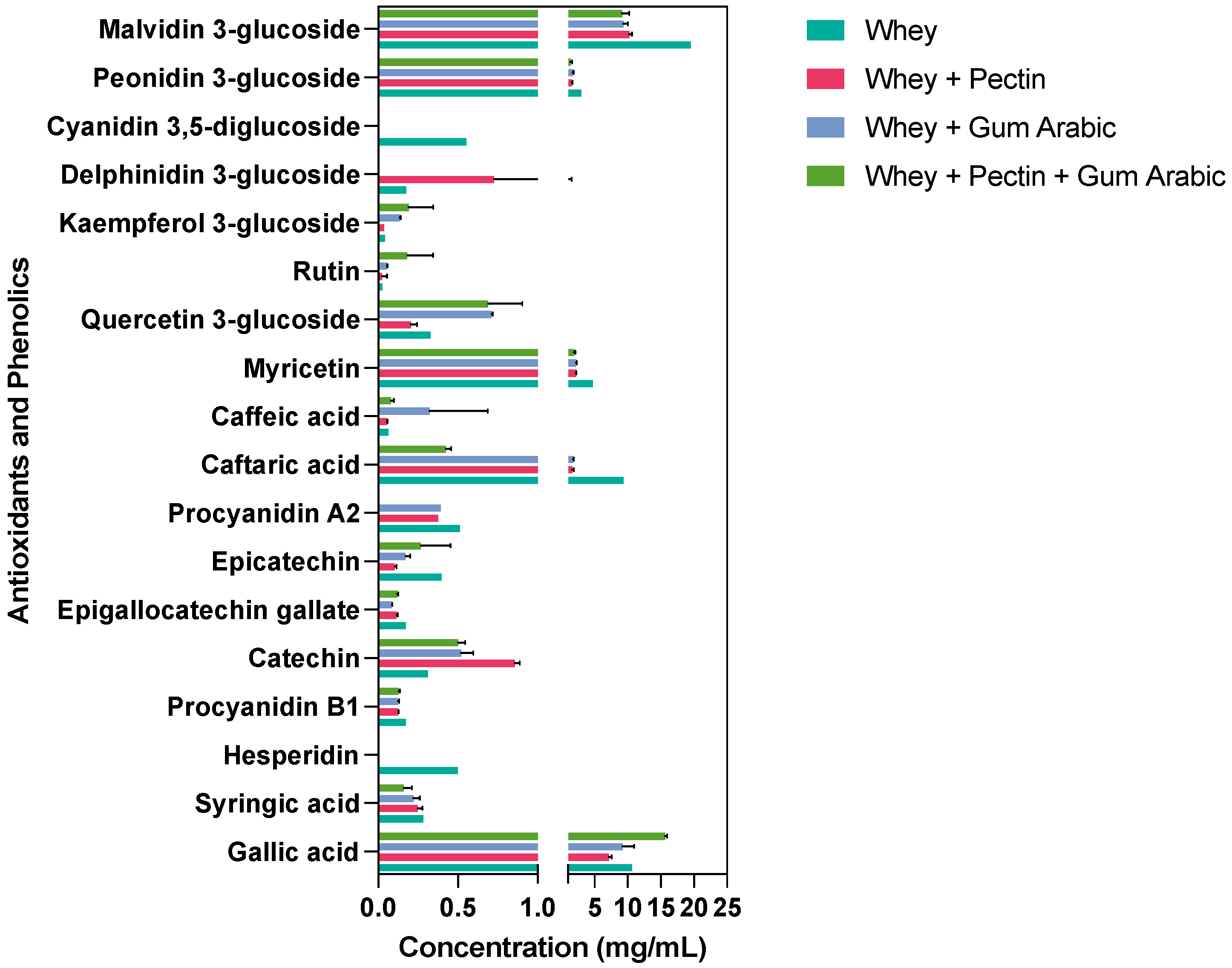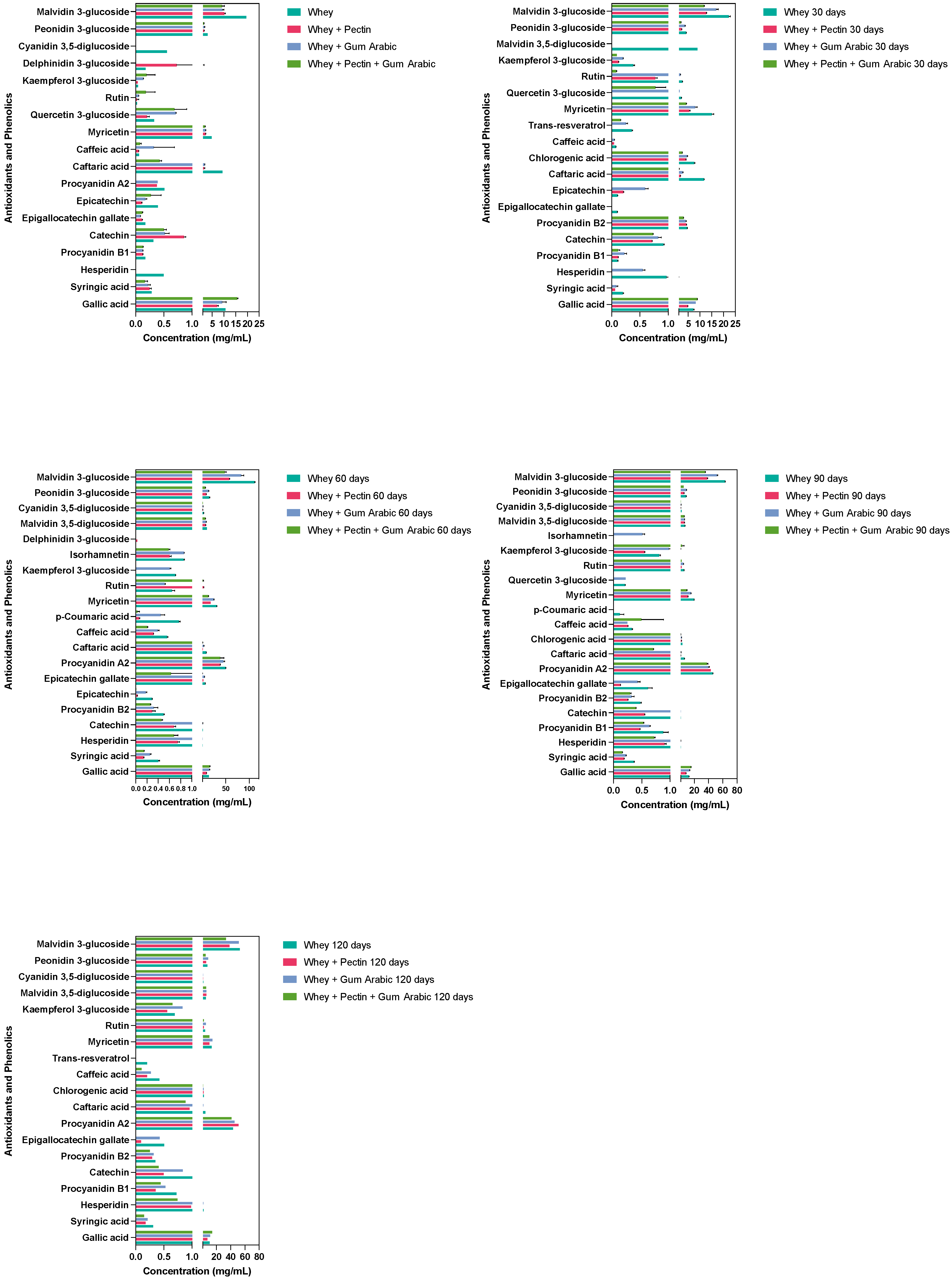Enhancing Antioxidant Retention through Varied Wall Material Combinations in Grape Spray Drying and Storage
Abstract
:1. Introduction
2. Materials and Methods
2.1. Materials
2.2. Grape Juice
2.3. Formulations
2.4. Spray Dryer
2.5. Storage
2.6. Phytochemical Parameters
2.6.1. Extraction and Quantification of the Individual Phenolic Compounds Using RP-HPLC/DAD
2.6.2. Total Bioactive Content (Total Phenolics)
2.6.3. Antioxidant Activity
2.7. Statistical Analysis
3. Results
3.1. Effect of Wall Material Combinations on Antioxidant Activity Retention
3.2. Effect of Wall Materials on Phenolic Compound Retention
3.3. Effect of Wall Materials on Antioxidant Properties and Phenolic Content during Storage
3.4. Effect of Wall Materials on the Kinetics of Degradation of the Phenolic Compounds
3.5. Effect of Wall Materials on Specific Phenolic and Antioxidant Molecules Retention after Spray Drying
3.6. Effect of Different Hydrocolloids on the Stability of Antioxidant and Phenolic Compounds during the Storage Period
4. Conclusions
Author Contributions
Funding
Institutional Review Board Statement
Informed Consent Statement
Data Availability Statement
Acknowledgments
Conflicts of Interest
References
- Koop, B.L.; da Silva, M.N.; da Silva, F.D.; dos Santos Lima, K.T.; Soares, L.S.; de Andrade, C.J.; Valencia, G.A.; Monteiro, A.R. Flavonoids, anthocyanins, betalains, curcumin, and carotenoids: Sources, classification and enhanced stabilization by encapsulation and adsorption. Food Res. Int. 2022, 153, 110929. [Google Scholar] [CrossRef] [PubMed]
- Dantas, D.; Pasquali, M.A.; Cavalcanti-Mata, M.; Duarte, M.E.; Lisboa, H.M. Influence of spray drying conditions on the properties of avocado powder drink. Food Chem. 2018, 266, 284–291. [Google Scholar] [CrossRef] [PubMed]
- Akinci, E.; Holthaus, D. Hydrocolloids and gums as encapsulating agents. In Microencapsulation in the Food Industry; Elsevier: Amsterdam, The Netherlands, 2023; pp. 309–323. [Google Scholar]
- Yao, T.; Janaswamy, S. Ordered hydrocolloids networks as delivery vehicles of nutraceuticals: Optimal encapsulation of curcumin and resveratrol. Food Hydrocoll. 2022, 126, 107466. [Google Scholar] [CrossRef]
- Devi, N.; Sarmah, M.; Khatun, B.; Maji, T.K. Encapsulation of active ingredients in polysaccharide–protein complex coacervates. Adv. Colloid Interface Sci. 2017, 239, 136–145. [Google Scholar] [CrossRef] [PubMed]
- Hosseini, S.M.H.; Emam-Djomeh, Z.; Sabatino, P.; Van der Meeren, P. Nanocomplexes arising from protein-polysaccharide electrostatic interaction as a promising carrier for nutraceutical compounds. Food Hydrocoll. 2015, 50, 16–26. [Google Scholar] [CrossRef]
- Neirynck, N.; Van der Meeren, P.; Gorbe, S.B.; Dierckx, S.; Dewettinck, K. Improved emulsion stabilizing properties of whey protein isolate by conjugation with pectins. Food Hydrocoll. 2004, 18, 949–957. [Google Scholar] [CrossRef]
- Weinbreck, F.; Vries, R.d.; Schrooyen, P.M.M.; Kruif, C.G.d. Complex coacervation of whey proteins and gum arabic. Biomacromolecules 2003, 4, 293–303. [Google Scholar] [CrossRef]
- Le, X.T.; Rioux, L.-E.; Turgeon, S.L. Formation and functional properties of protein–polysaccharide electrostatic hydrogels in comparison to protein or polysaccharide hydrogels. Adv. Colloid Interface Sci. 2017, 239, 127–135. [Google Scholar] [CrossRef]
- Lavelli, V.; Harsha, P.S. Microencapsulation of grape skin phenolics for pH controlled release of antiglycation agents. Food Res. Int. 2019, 119, 822–828. [Google Scholar] [CrossRef]
- Magrone, T.; Magrone, M.; Russo, M.A.; Jirillo, E. Recent advances on the anti-inflammatory and antioxidant properties of red grape polyphenols: In vitro and in vivo studies. Antioxidants 2019, 9, 35. [Google Scholar] [CrossRef]
- Nilsson, J.; Pillai, D.; Önning, G.; Persson, C.; Nilsson, Å.; Åkesson, B. Comparison of the 2,2′-azinobis-3-ethylbenzotiazo-line-6-sulfonic acid (ABTS) and ferric reducing anti-oxidant power (FRAP) methods to asses the total antioxidant capacity in extracts of fruit and vegetables. Mol. Nutr. Food Res. 2005, 49, 239–246. [Google Scholar] [CrossRef]
- Lisboa, H.M.; Duarte, M.E.; Cavalcanti-Mata, M.E. Modeling of food drying processes in industrial spray dryers. Food Bioprod. Process. 2018, 107, 49–60. [Google Scholar] [CrossRef]
- Burin, V.M.; Ferreira-Lima, N.E.; Panceri, C.P.; Bordignon-Luiz, M.T. Bioactive compounds and antioxidant activity of Vitis vinifera and Vitis labrusca grapes: Evaluation of different extraction methods. Microchem. J. 2014, 114, 155–163. [Google Scholar] [CrossRef]
- Barreto, S.M.A.; da Silva, A.B.M.; Dutra, M.d.C.P.; Bastos, D.C.; Carvalho, A.J.d.B.A.; Viana, A.C.; Narain, N.; dos Santos Lima, M. Effect of commercial yeasts (Saccharomyces cerevisiae) on fermentation metabolites, phenolic compounds, and bioaccessibility of Brazilian fermented oranges. Food Chem. 2023, 408, 135121. [Google Scholar] [CrossRef]
- Margraf, T.; Karnopp, A.R.; Rosso, N.D.; Granato, D. Comparison between Folin-Ciocalteu and Prussian Blue assays to estimate the total phenolic content of juices and teas using 96-well microplates. J. Food Sci. 2015, 80, C2397–C2403. [Google Scholar] [CrossRef]
- Re, R.; Pellegrini, N.; Proteggente, A.; Pannala, A.; Yang, M.; Rice-Evans, C. Antioxidant activity applying an improved ABTS radical cation decolorization assay. Free. Radic. Biol. Med. 1999, 26, 1231–1237. [Google Scholar] [CrossRef] [PubMed]
- Kim, Y.K.; Guo, Q.; Packer, L. Free radical scavenging activity of red ginseng aqueous extracts. Toxicology 2002, 172, 149–156. [Google Scholar] [CrossRef]
- Rufino, M.; Alves, R.; de Brito, E.; Mancini Filho, J.; Moreira, A. Metodologia científica: Determinação da Atividade Antioxidante Total em Frutas no Sistema Beta-Caroteno/ácido Linoléico; Technical Communication 125; Embrapa AgroIndustria Tropical: Fortaleza, Brazil, 2006; Available online: https://ainfo.cnptia.embrapa.br/digital/bitstream/CNPAT-2010/11964/1/cot-125.pdf (accessed on 6 September 2023).
- Pedrali, D.; Scarafoni, A.; Giorgi, A.; Lavelli, V. Binary Alginate-Whey Protein Hydrogels for Antioxidant Encapsulation. Antioxidants 2023, 12, 1192. [Google Scholar] [CrossRef] [PubMed]
- Akbari, N.; Assadpour, E.; Kharazmi, M.S.; Jafari, S.M. Encapsulation of Vitamin B12 by Complex Coacervation of Whey Protein Concentrate–Pectin; Optimization and Characterization. Molecules 2022, 27, 6130. [Google Scholar] [CrossRef] [PubMed]
- Shao, P.; Feng, J.; Sun, P.; Ritzoulis, C. Improved emulsion stability and resveratrol encapsulation by whey protein/gum arabic interaction at oil-water interface. Int. J. Biol. Macromol. 2019, 133, 466–472. [Google Scholar] [CrossRef]
- Yadav, K.; Bajaj, R.K.; Mandal, S.; Mann, B. Encapsulation of grape seed extract phenolics using whey protein concentrate, maltodextrin and gum arabica blends. J. Food Sci. Technol. 2020, 57, 426–434. [Google Scholar] [CrossRef]
- Lekshmi, R.K.; Tejpal, C.; Anas, K.; Chatterjee, N.; Mathew, S.; Ravishankar, C. Binary blend of maltodextrin and whey protein outperforms gum Arabic as superior wall material for squalene encapsulation. Food Hydrocoll. 2021, 121, 106976. [Google Scholar] [CrossRef]
- Zhang, Z.-H.; Yu, B.; Xu, Q.; Bai, Z.; Ji, K.; Gao, X.; Wang, B.; Aadil, R.M.; Ma, H.; Xiao, R. The Physicochemical Properties and Antioxidant Activity of Spirulina (Artrhospira platensis) Chlorophylls Microencapsulated in Different Ratios of Gum Arabic and Whey Protein Isolate. Foods 2022, 11, 1809. [Google Scholar] [CrossRef]
- Cortés-Morales, E.A.; Mendez-Montealvo, G.; Velazquez, G. Interactions of the molecular assembly of polysaccharide-protein systems as encapsulation materials. A review. Adv. Colloid Interface Sci. 2021, 295, 102398. [Google Scholar] [CrossRef]
- Martín-Gómez, J.; García-Martínez, T.; Varo, M.Á.; Mérida, J.; Serratosa, M.P. Phenolic compounds, antioxidant activity and color in the fermentation of mixed blueberry and grape juice with different yeasts. LWT 2021, 146, 111661. [Google Scholar] [CrossRef]
- Esfanjani, A.F.; Jafari, S.M.; Assadpoor, E.; Mohammadi, A. Nano-encapsulation of saffron extract through double-layered multiple emulsions of pectin and whey protein concentrate. J. Food Eng. 2015, 165, 149–155. [Google Scholar] [CrossRef]
- Farrag, A.; El-Messery, T.M.; El-Said, M.M.; Soliman, T.; El-Din, H.M.F. Microencapsulation of grape phenolic compounds using whey proteins as a carrier vehicle. J. Biol. Sci. 2018, 18, 373–380. [Google Scholar] [CrossRef]
- Navarro-Flores, M.J.; Ventura-Canseco, L.M.C.; Meza-Gordillo, R.; Ayora-Talavera, T.d.R.; Abud-Archila, M. Spray drying encapsulation of a native plant extract rich in phenolic compounds with combinations of maltodextrin and non-conventional wall materials. J. Food Sci. Technol. 2020, 57, 4111–4122. [Google Scholar] [CrossRef]
- Feng, S.; Sun, Y.; Wang, P.; Sun, P.; Ritzoulis, C.; Shao, P. Co-encapsulation of resveratrol and epigallocatechin gallate in low methoxyl pectin-coated liposomes with great stability in orange juice. Int. J. Food Sci. Technol. 2020, 55, 1872–1880. [Google Scholar] [CrossRef]
- Vidinamo, F.; Fawzia, S.; Karim, M. Effect of drying methods and storage with agro-ecological conditions on phytochemicals and antioxidant activity of fruits: A review. Crit. Rev. Food Sci. Nutr. 2021, 62, 353–361. [Google Scholar] [CrossRef] [PubMed]
- Hu, Y.; Li, Y.; Zhang, W.; Kou, G.; Zhou, Z. Physical stability and antioxidant activity of citrus flavonoids in arabic gum-stabilized microcapsules: Modulation of whey protein concentrate. Food Hydrocoll. 2018, 77, 588–597. [Google Scholar] [CrossRef]
- Martins, G.M.V.; de Sousa, S.; Duarte, M.E.M.; Cavalcanti-Mata, M.E.R.M.; Oliveira, H.M.L. Modeling the combinatory effects of parboiling and cooking on red paddy rice (Oryza sativa L.) properties. LWT 2021, 147, 111607. [Google Scholar] [CrossRef]
- Li, R.; Guo, Y.; Dong, A.; Yang, X. Protein-based emulsion gels as materials for delivery of bioactive substances: Formation, structures, applications and challenges. Food Hydrocoll. 2023, 144, 108921. [Google Scholar] [CrossRef]
- Budiyanto, A.; Usmiati, S.; Ismail, M.; Batubara, S.; Sulistiyani, T. The effect of types and concentration of fillers on the quality of whey protein products. IOP Conf. Ser. Earth Environ. Sci. 2021, 803, 012042. [Google Scholar] [CrossRef]
- Dehghani, S.; Hosseini, S.V.; Regenstein, J.M. Edible films and coatings in seafood preservation: A review. Food Chem. 2018, 240, 505–513. [Google Scholar] [CrossRef] [PubMed]
- Carneiro, H.C.; Tonon, R.V.; Grosso, C.R.; Hubinger, M.D. Encapsulation efficiency and oxidative stability of flaxseed oil microencapsulated by spray drying using different combinations of wall materials. J. Food Eng. 2013, 115, 443–451. [Google Scholar] [CrossRef]
- Wang, Y.; Guo, Y.; Zhang, L.; Yuan, M.; Zhao, L.; Bai, C.; McClements, D.J. Impacts of hesperidin on whey protein functionality: Interacting mechanism, antioxidant capacity, and emulsion stabilizing effects. Front. Nutr. 2023, 9, 3151. [Google Scholar] [CrossRef]
- Evans, M.; Ratcliffe, I.; Williams, P.A. Emulsion stabilisation using polysaccharide–protein complexes. Curr. Opin. Colloid Interface Sci. 2013, 18, 272–282. [Google Scholar] [CrossRef]
- Liu, X.; Le Bourvellec, C.; Renard, C.M. Interactions between cell wall polysaccharides and polyphenols: Effect of molecular internal structure. Compr. Rev. Food Sci. Food Saf. 2020, 19, 3574–3617. [Google Scholar] [CrossRef]



| Experiments | Units | Grape Pulp | Whey Protein | Pectin | Gum Arabic |
|---|---|---|---|---|---|
| W | g/100 g | 85% | 15% | - | - |
| P | g/100 g | 83% | 15% | 2% | - |
| G | g/100 g | 83% | 15% | - | 2% |
| M | g/100 g | 81% | 15% | 2% | 2% |
| pH | 4.38 ± 0.012 b | 4.41 ± 0.08 b | 4.47 ± 0.06 a | 4.46 ± 0.01 ab | |
| Spray-drying conditions | |||||
| Drying gas flow rate | Kg/h | 200 ± 5.0 | 200 ± 5.0 | 200 ± 5.0 | 200 ± 5.0 |
| Feed flow rate | kg/h | 2.2 ± 0.1 | 2.2 ± 0.1 | 2.2 ± 0.1 | 2.2 ± 0.1 |
| Atomization flow rate | Kg/h | 2.2 ± 0.2 | 2.2 ± 0.2 | 2.2 ± 0.2 | 2.2 ± 0.2 |
| Inlet temperature | °C | 160 ± 2 | 160 ± 2 | 160 ± 2 | 160 ± 2 |
| Outlet temperature | °C | 91 ± 1 | 91 ± 1 | 91 ± 1 | 91 ± 1 |
| Time | Method | Experiments | |||
|---|---|---|---|---|---|
| Whey | Whey + Pectin | Whey + Gum Arabic | Whey + Pectin + Gum Arabic | ||
| 0 days | DPPH (mmol TEAC L−1) | 7.31 ± 0.12 a | 6.53 ± 0.12 abc | 4.42 ± 0.55 def | 6.53 ± 0.25 abc |
| FRAP | 34.98 ± 0.14 bc | 41 ± 1.34 a | 43.68 ± 0.02 a | 45.16 ± 0.18 a | |
| ABTS | 16.22 ± 0.21 a | 14.77 ± 0.63 ab | 14 ± 3.39 ab | 12.09 ± 0.51 bcde | |
| Phenolic content | 8955 ± 21.37 cdefg | 10,458 ± 245 bc | 7843 ± 91.55 fghi | 9770 ± 74.91 cde | |
| 30 days | DPPH (mmol TEAC L−1) | 6.87 ± 0.65 ab | 6.39 ± 0.06 abcd | 4.27 ± 0.30 efg | 4.86 ± 0.08 bcdef |
| FRAP | 32.47 ± 0.37 cd | 35 ± 1.71 bc | 29 ± 1.29 d | 43.68 ± 0.02 a | |
| ABTS | 15.79 ± 0.14 a | 13.61 ± 0.64 abc | 10.89 ± 0.33 cde | 11.64 ± 0.53 bcde | |
| Phenolic content | 8511 ± 111.37 defgh | 9031 ± 29.13 cdef | 6116 ± 212.24 i | 10,326 ± 29.13 bcd | |
| 60 days | DPPH (mmol TEAC L−1) | 6.61 ± 0.08 abc | 6.54 ± 0.62 abc | 3.60 ± 0.03 fgh | 4.71 ± 0.65 cdef |
| FRAP | 24.82 ± 0.02 ef | 34.48 ± 0.05 bc | 23.75 ± 0.91 efg | 36.95 ± 0.41 b | |
| ABTS | 14 ± 1.98 ab | 12.83 ± 0.24 abcd | 10.40 ± 0.34 cdef | 9.99 ± 0.05 cdef | |
| Phenolic content | 7461 ± 103.98 fghi | 8307 ± 66.58 efgh | 6207 ± 82.24 | 11,972 ± 29.13 ab | |
| 90 days | DPPH (mmol TEAC L−1) | 5.91 ± 0.12 abcde | 5.98 ± 0.93 abcde | 2.23 ± 0.67 gh | 3.58 ± 0.05 fgh |
| FRAP | 22.01 ± 0.91 fgh | 20 ± 1.05 gh | 18.82 ± 0.62 h | 33 ± 2.93 bcd | |
| ABTS | 10.62 ± 0.19 cdef | 10.87 ± 0.05 cde | 8.80 ± 0.75 ef | 8.98 ± 0.25 ef | |
| Phenolic content | 7736 ± 87.15 fghi | 7023 ± 253.22 hi | 6003.97 ± 187.2 | 13,741 ± 240.1 a | |
| 120 days | DPPH (mmol TEAC L−1) | 3.60 ± 0.01 fgh | 4.13 ± 0.03 efg | 2.11 ± 0.23 h | 3.31 ± 0.78 fgh |
| FRAP | 18.63 ± 0.42 h | 25.87 ± 0.51 e | 12.57 ± 0.44 i | 21.69 ± 0.79 fgh | |
| ABTS | 8.93 ± 0.08 ef | 9.21 ± 0.33 def | 7.21 ± 0.05 fg | 5.11 ± 0.08 g | |
| Phenolic content | 7122 ± 14.56 ghi | 7293 ± 66.58 fgh | 6732 ± 44.94 hi | 13,251 ± 362 a | |
| Whey | Whey + Pectin | Whey + Gum Arabic | Whey + Pectin + Gum Arabic | |
|---|---|---|---|---|
| Zero-order kinetic model—Phenolic content | ||||
| B0 | 8901 | 10,145 | 7440 | 13,986 |
| B1 | −15.72 | −28.7 | −14.32 | −36.22 |
| R2 | 0.9691 | 0.9547 | 0.8004 | 0.9683 |
| First-order kinetic model—Phenolic content | ||||
| Y0 | 8998 | 10,448 | 7848 | 13,986 |
| K | −0.006664 | −0.0112 | −0.03096 | −0.00000441 |
| R squared | 0.9837 | 0.992 | 0.9981 | 0.9683 |
| Zero-order kinetic model—DPPH | ||||
| B0 | 7.888 | 7.028 | 4.702 | 6.146 |
| B1 | −0.02873 | −0.01661 | −0.02357 | −0.02573 |
| R squared | 0.7955 | 0.5486 | 0.9293 | 0.9169 |
| First-order kinetic model—DPPH | ||||
| Y0 | 7.888 | 7.028 | 4.702 | 6.449 |
| K | −0.000003144 | −0.000003401 | −0.000006607 | −0.01271 |
| R squared | 0.7954 | 0.5486 | 0.9292 | 0.957 |
| Zero-order kinetic model—FRAP | ||||
| B0 | 35.22 | 42.59 | 31.04 | 47.21 |
| B1 | −0.1421 | −0.1745 | −0.2022 | −0.1685 |
| R squared | 0.9676 | 0.9741 | 0.9923 | 0.7955 |
| First-order kinetic model—FRAP | ||||
| Y0 | 35.56 | 42.59 | 31.76 | 47.21 |
| K | −0.002602 | −0.000001832 | −0.003903 | −3.795 × 10−6 |
| R squared | 0.9699 | 0.9741 | 0.9968 | 0.7954 |
| Zero-order kinetic model—ABTS | ||||
| B0 | 16.84 | 15.11 | 16.08 | 16.72 |
| B1 | −0.06582 | −0.04878 | −0.08206 | −0.09801 |
| R squared | 0.9669 | 0.966 | 0.8044 | 0.9003 |
| First-order kinetic model—ABTS | ||||
| Y0 | 16.84 | 15.11 | 18.34 | 18.09 |
| K | −0.000002279 | −0.000001034 | −0.03353 | −0.01551 |
| R squared | 0.9669 | 0.966 | 0.9622 | 0.9457 |
Disclaimer/Publisher’s Note: The statements, opinions and data contained in all publications are solely those of the individual author(s) and contributor(s) and not of MDPI and/or the editor(s). MDPI and/or the editor(s) disclaim responsibility for any injury to people or property resulting from any ideas, methods, instructions or products referred to in the content. |
© 2023 by the authors. Licensee MDPI, Basel, Switzerland. This article is an open access article distributed under the terms and conditions of the Creative Commons Attribution (CC BY) license (https://creativecommons.org/licenses/by/4.0/).
Share and Cite
Nascimento, A.P.S.; Carvalho, A.J.d.B.A.; Lima, M.d.S.; Barros, S.L.; Ribeiro, S.; Pasqualli, M.; Lisboa, H.M.; Barros, A.N. Enhancing Antioxidant Retention through Varied Wall Material Combinations in Grape Spray Drying and Storage. Antioxidants 2023, 12, 1745. https://doi.org/10.3390/antiox12091745
Nascimento APS, Carvalho AJdBA, Lima MdS, Barros SL, Ribeiro S, Pasqualli M, Lisboa HM, Barros AN. Enhancing Antioxidant Retention through Varied Wall Material Combinations in Grape Spray Drying and Storage. Antioxidants. 2023; 12(9):1745. https://doi.org/10.3390/antiox12091745
Chicago/Turabian StyleNascimento, Amanda Priscila Silva, Ana Júlia de Brito Araújo Carvalho, Marcos dos Santos Lima, Samela Leal Barros, Samara Ribeiro, Matheus Pasqualli, Hugo M. Lisboa, and Ana Novo Barros. 2023. "Enhancing Antioxidant Retention through Varied Wall Material Combinations in Grape Spray Drying and Storage" Antioxidants 12, no. 9: 1745. https://doi.org/10.3390/antiox12091745
APA StyleNascimento, A. P. S., Carvalho, A. J. d. B. A., Lima, M. d. S., Barros, S. L., Ribeiro, S., Pasqualli, M., Lisboa, H. M., & Barros, A. N. (2023). Enhancing Antioxidant Retention through Varied Wall Material Combinations in Grape Spray Drying and Storage. Antioxidants, 12(9), 1745. https://doi.org/10.3390/antiox12091745








